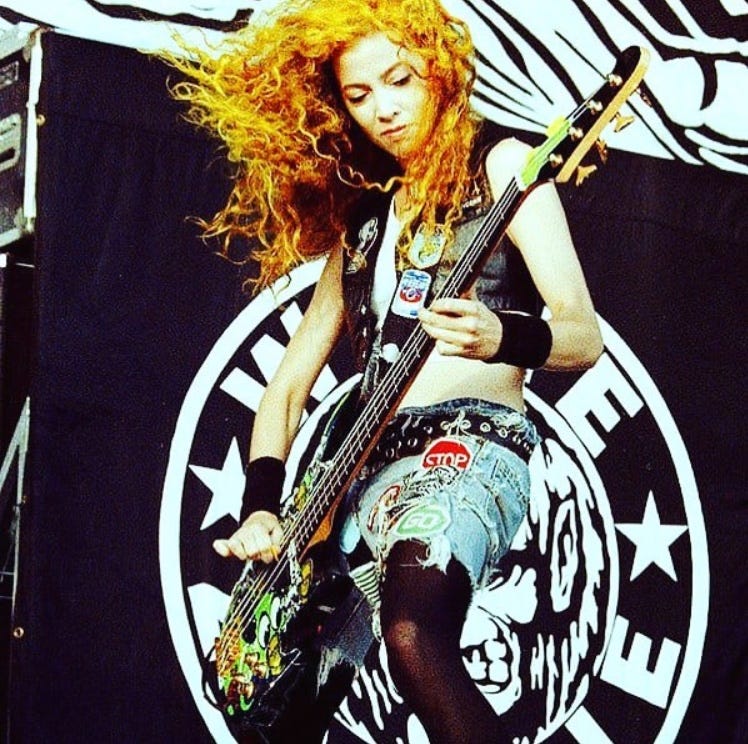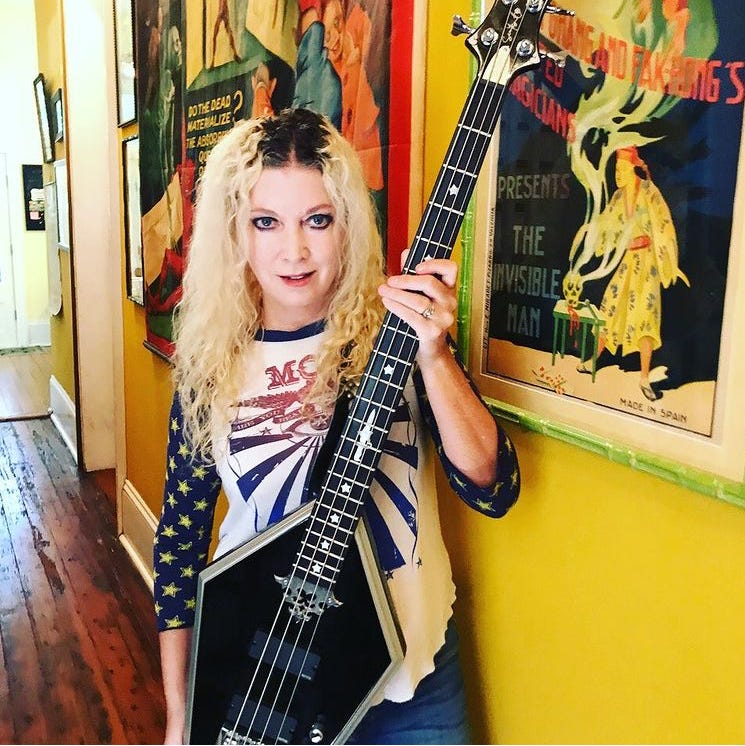Motor-Psycho Nightmares: White Zombie's Sean Yseult on 29 years of La Sexorcisto: Devil Music Vol. 1

White Zombie’s trajectory was a wild one. Chronicled on 2016’s excellent It Came from N.Y.C. compendium, the group’s early days swung from a gothic, Cramps-inspired debut 7” towards the cerebellum-mangling noise-rock dissonance of debut LP Soul-Crusher, and onto the reverb-heavy crunch of 1989’s Make Them Die Slowly. By 1995, the band’s final album, Astro-Creep: 2000, mutated the template towards a dance-inspired industrial stomp that was indeed more human than human.
Released on March 17, 1992, White Zombie’s third album, La Sexorcisto: Devil Music Vol. 1, was the first to capture imaginations on a grand scale. Thanks are, in part, owed to the zeitgeist tastemaking of Beavis and Butthead—the animated doofuses air-drumming and couch-moshing along to the cryptic motor-metal groove of “Thunder Kiss ’65,” proclaiming that MTV “should play this video all day long”— but the band wouldn’t have gotten any traction without the chops to back it up. In contrast to those earlier noisescapes, bassist Sean Yseult—who co-founded White Zombie with Rob Zombie back in 1985— and guitarist J. Yuenger ground into a darker sense of rhythm on tracks like “Thunder Kiss ‘65” and “Black Sunshine,” injecting “true death: 400 Horsepower of maximum performance” into the album’s sensory overload of distortion, drums, and b-movie samples.
Over the past year, Sean has been looking back at her time with White Zombie by selling off various pieces of memorabilia—think monogrammed tour towels, promo photos, bootleg band t’s the band bought in arena parking lots, and postcards showcasing beastly characters concocted by Rob Zombie— over at https://lamadamabazarre.bigcartel.com. She’s also been busy updating her current Yseult Designs line of scarves, pillows, and wallpaper; is busy planning her next photography exhibition; and her I’m in the Band photo book/tour memoir is currently in its third pressing.
Speaking with Gut Feeling, Sean got into the everlasting groove of La Sexorcisto, unearthing gritty tones with her signature Casket bass, and the eventual release of her “Pandemic Rag.”
Through the beginning of the pandemic and into this year you’ve been auctioning off various pieces of White Zombie memorabilia you’d been hanging onto since the very beginning of the band. What kinds of memories were brought up as you went through those boxes, and what was it like to let it all go?
Sean Yseult: It was no problem to let it go; I felt silly having had it take up so much storage space for two decades! And it was certainly nice to have so many fans wanting the items and giving them good homes instead of sitting in boxes, in the dark. I’m actually finding more, now that I have cleaned out that first layer of boxes, so keep your eyes open on my social media pages!
So many great memories came back with every t-shirt, poster and item— mostly reminders of fun times on tour with bands that I loved, and how great our fans were. There are many items that fans gifted me also —cool handmade banners and things they knew I collected, like Casper, Hot Stuff, old patches— and I would never part with those items!
La Sexorcisto is a pivotal album for White Zombie, being the band’s first for a major label, and also your commercial breakthrough. What can you recall about the momentum the band had built up to that point, and what your hopes had been for what was yet to come?
S: Before La Sexorcisto came out, we had toured enough to fill small clubs. We had toured the U.S. for a few years and finished a long European tour before signing to Geffen. We had no idea that the road we were on was going to lead to selling out arenas. Our hopes were to one day sell out small theaters like some of our favorite bands, the Ramones and the Cramps. Geffen didn’t even have a budget for us to make a video, while other bands that barely sold a record were getting outrageous sums of money to shoot videos. We finally talked them into giving us $15,000 to make the “Thunderkiss ‘65” video, which was barely enough to cover the price of the film. Nobody got paid, not even the director.
If that video hadn’t been made, we would have never been seen on Headbangers Ball, Beavis and Butthead, and then eventually in heavy rotation on MTV. Between that and all of the great bands that gave us a chance as their opener, our crowds steadily grew bigger and bigger and record sales began to take off. Needless to say our hopes were far surpassed beyond our wildest dreams.
The overall production of La Sexorcisto has more low-end to it than Make Them Die Slowly—even J.’s guitars are substantially chunkier. For your part, what were you seeking in terms of your bass tone, and what were you playing with at the time?
S: J. and I both were playing Charvels at that time— we got them because Sam Ash was having a crazy sale on them right around when we were about to record, and if I remember correctly, Slayer played on Charvels then, so we thought they must be the right guitars! I was always going for a heavy but clear sound—not too bright, but also not muffled or soft. I had a Marshall Jubilee series bass stack; I always wanted to sound like Lemmy on bass! We did not have a second guitarist and I wrote a lot of the riffs, so my bass needed to sound heavy but also fill in on mid-tones.
Compared to your earliest records, there is arguably a deeper, scuzzier sense of groove to La Sexorcisto pieces like “Soul-Crusher,” “Grindhouse (A Go Go),” and “Thunderkiss ‘65.” Was there a sense during the writing sessions that the band’s approach to rhythm was shifting?
S: Yes. We were still living in NYC back then, and listening to a lot of rap: Ice-T, Run-DMC, LL Cool J, and especially Public Enemy. Rob was very intent on merging some of the rhythms and beats of what we were hearing into some of our songs, and it worked well.
“Thunderkiss ‘65” became the band’s signature hit, understated with its main riff but undeniably heavy. What can you remember about the feeling of playing the song together for the first time, and likewise the feeling of seeing massive audiences getting charged up once that intro hits?
S: Playing it for the first time, writing as we went along, was one of the easiest songs we ever worked on together. Rob had the beat, J. wrote the main riff over it, and I wrote the breakdown in the middle. Seeing audiences react was just incredible. J. would start quietly with the single note, the rhythm, and people would yell, then wait with anticipation. When the drums and bass would kick in at the end of the opening riff, it would be total mayhem! Mosh pit insanity. It was really exciting to watch every night.
What’s your favourite riff on the album?
S: I really enjoy “Black Sunshine.” I wrote the main two riffs in 3/8 timing— It sounds even more complex than it is because our drummer was always playing 4/4 timing. It would meet up on the 8th measure, but it created a new kind of feel, two time signatures overlapping each other. I also really enjoyed the opening riff of “Soul-Crusher,” which is a notey demonic riff I wrote in 7/8 time but once again the drummer is playing 4/4, and it oddly works in a more complex way.
You went on two years of solid touring to support La Sexorcisto. How much had you experimented with your live rig in that time, or were you locked into a pretty steady set-up the whole way through?
S: I was completely locked in with my Marshall bass stack. I really loved it. Later I moved on to Ampeg with an SVT and 8x10 cabinet, which I also love. Honestly, if I set all of the dials to 12:00, my bass sounded great. Marshall, Ampeg—it is weird magic for me, but it always works.
Schecter had made up a signature Casket Bass for you a few years back. What kind of specs did you have in mind when helping design an instrument, from electronics to shape? And is the Casket Bass still your go-to instrument?
S: The owner, Michael Ciravolo, came up to me one day and offered to make me any bass I have ever wanted. I quickly sketched out my idea for the coffin bass, and he had one made for me! I’m a designer by degree and not a gear head; I just told him to make it play loud and bright enough, and left the tech details to the pros. I still love my coffins and get requests for them daily. Schecter still make them for sale to this day!

Have you been making any new music through the pandemic?
S: Yes! I have mostly been working on my new design line and new photo show, but one day during COVID I woke up with a song in my head. I went down to my music room to figure it out and write down the notation. It’s a ragtime piece on piano, and I call it “The Pandemic Rag.” I’m planning on recording a performance of it soon and posting it online. My new design line I worked on through COVID is up and available online at yseultdesigns.com, and my new photo show, “Dorveille,” will have a one day outdoors showing in May and then also go online at seanyseult.com. Keeping busy!
